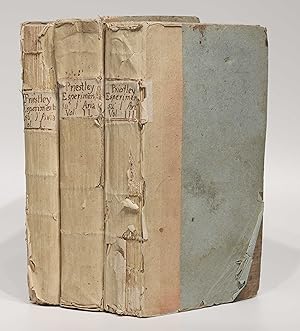Beschreibung
1774-1777. 8vo (228 x 140 mm). 6 engraved plates including frontispiece to each volume (3 plates folding). Vol. I with half-title, 2 unnumbered leaves with 1 p. errata and 3 pp. adverts at rear; vol. II and III with 1 p. errata, index and 2 advert leaves at rear. [2], xxiii, [5], 324, [4]; xliv, 399, [21]; xxxiv, [6], 411, [13] pp. Publisher's uniform paper-backed drab boards, all edges uncut (vol. III partly unopened), spines with hand-lettered paper label added by early owner (some fraying and chipping with some loss of paper over spines and boards, minor dust-soiling and spotting, corners of vol. II bumped). Internally quite crisp and clean throughout with occasional very minor spotting and browning of paper, little fraying and dust-soiling to outer margins, dog-earing in places; vol. I with small pale brown stain near outer corners, light offsetting from face-to-face folding of frontispiece, errata corrected in ink to pp. 260, 306 and 311; vol. II with clean tear near center of title (w/o loss), p. 219/20 with tear at upper margin not affecting text; vol. III with single narrow wormtrack to upper margin of gatherings S-T and X extending into text area and affecting a few letters. Provenance: from a private French library. A highly unsophisticated and unrepaired, clean and bright copy; absolutely complete with the rare half-title leaf to first volume. ---- EXCEPTIONAL SET IN FIRST EDITION. Joseph Priestley's "Observations on different kinds of air" were first published in the Philosophical Transactions in 1772. As the experiments themselves were performed at such a prolific rate, it was decided to publish them in book form. "During this period - in addition to his discovery of oxygen - Priestley described the isolation and identification of ammonia, sulfur dioxide, nitrous oxide and nitrogen dioxide, and silicon terafluoride. He discussed the properties of mineral acids; further extended the knowledge of photosynthesis; defined the role of blood in respiration: and noted, unknowingly, the differential diffusion of gases through porous containers. More than any other person, he established the experimental techniques of pneumatic chemistry. For over a decade Priestley dominated the scientific scene in Britain and attracted the attention of scientists throughout Europe. In 1784 he was elected one of the eight foreign associates of the Royal Academy of Sciences in Paris, and he was similarly honored by nearly a score of memberships in other scientific societies from Boston and Philadelphia to Stockholm and St. Petersburgh" (DSB). "Priestley's hundreds of experiments on different types of 'air' led to the identification of numerous gases, including ammonia, nitrogen dioxide and (most importantly) oxygen, which he obtained by heating mercuric oxide. Although the Swedish chemist Scheele [. . .] had succeeded in isolating oxygen at least two years before Priestley, Priestley was long credited with the discovery of oxygen, as he was the first to publish his discovery. Priesdey's experiments with gases led Cavendish and Watt to discover the compound nature of water, and it was this revelation, coupled with Priestley's isolation of oxygen, that formed the experimental basis of Lavoisier's new oxidation chemistry" (Norman). Complete sets with all the three parts in first edition are quite rare. An uncut set in uniform original boards however is of utmost rarity. We know of no other set that has come to market in the past 50+ years. The Norman copy was a mixed set with volumes II and III in original boards only. References: Duveen p. 484; Grolier/Horblit 85; Norman 1750; R.E. Schofield, Priestley, Joseph, in: DSB XI, pp. 145-146. - Visit our website to see more images! Bestandsnummer des Verkäufers 003854
Verkäufer kontaktieren
Diesen Artikel melden
![]()




